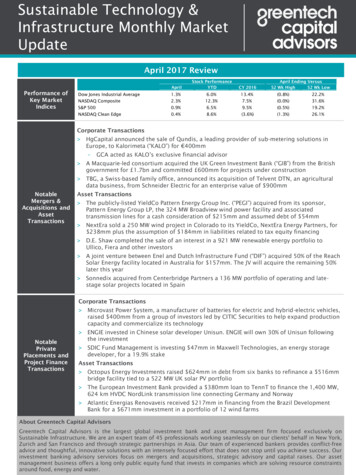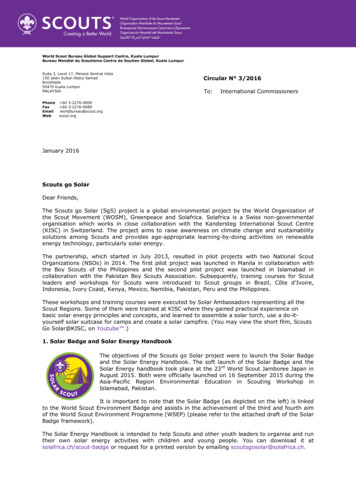
Transcription
www.pwc.comSolar Park of2000 MWCapacity in theState ofKarnataka, IndiaStrictly Private andConfidential22thDecember 2015Detailed Project Report (DPR)
Table of ContentsTable of contents1. Executive Summary12. Introduction92.1. Overview of power scenario in India92.1.1. Overview of current status of electricity demand and supply in India102.2. Current Status of Power Sector in Karnataka122.2.1. Consumer-Category wise Consumption122.2.2. Demand Supply Assessment132.2.3. Industry Structure132.3. Renewable Energy scenario in India142.4. Solar Energy development in India162.5. Policy and Regulatory landscape for Solar in India172.5.1. Electricity Act 2003 (EA 2003)172.5.2. National Electricity Policy 2005182.5.3. National Tariff Policy, 2006192.5.4. National Action Plan for Climate Change (NAPCC)192.5.5. Renewable Energy Certificate (REC) Mechanism192.5.6. FOR policies on renewable energy202.6. Incentives available to Solar Projects in India202.6.1. Jawaharlal Nehru National Solar Mission (JNNSM)212.6.2. Preferential tariff for inter -state renewable projects242.7. Solar Potential in state of Karnataka272.7.1. Policy Initiative for Solar Promotion272.7.2. Rationale for Solar Park282.8. MNRE Scheme for solar parks and UMPPs283. Site Assessment353.1. Site Assessment Criteria363.1.1. Introduction363.1.2. Exclusion Criteria and Areas373.1.3. Assessment of site conditions373.2. The Location – District Tumkur (Karnataka)413.2.1. Pavagada423.2.2. Connectivity and Accessibility423.2.3. Climate and Rainfall433.2.4. Geomorphology and Soil Type433.2.5. Hydrogeology43
Table of Contents3.2.6. Seismic443.2.7. Water443.2.8. Power Evacuation444. Solar Radiation Resource Assessment484.1. Background484.2. Solar Radiation over India494.3. Solar Radiation Databases504.3.1. Ground (measured) data514.3.2. Databases based on satellite images514.3.3. Derived databases and system integrating data514.4. Solar Radiation Databases in context of India514.4.1. IMD Database (Ground Data)514.4.2. C-WET data (Ground Data)524.4.3. RETScreen Data534.4.4. Satellite Database – NASA Satellite Data534.4.5. Satellite Database – NREL Satellite data544.4.6. Satellite Database – SWERA Data544.4.7. 3TIER Data564.4.8. ISHRAE Weather Database564.4.9. SolarGIS Data564.4.10. Meteonorm Database564.5. Solar Radiation over Tumkur, Karnataka574.6. Solar radiation over Tumkur574.6.1. IMD Data584.6.2. NASA Satellite Data594.6.3. SWERA Satellite Data594.6.4. SEC-NREL Satellite Data604.6.5. Meteonorm (6.0) Time Series Data604.6.6. Meteonorm (7.0)- Time Series Data604.6.7. SolarGIS Data614.7. Optimization of the Solar Radiation Database (GHI)624.8. Climatic Study of Tumkur, Karnataka665. Assessment of Solar Photovoltaic (SPV) Module Technologies725.1. Global Scenario of Solar PV725.2. Indian Scenario745.3. Solar PV system765.3.1. Wafer-based crystalline silicon solar cell technology775.3.2. Thin film solar cell technology78
Table of Contents5.3.3. Concentrating solar photovoltaic (CPV)795.4. Market Share815.5. SPV Technology Selection for the Project site at Tumkur, Karnataka815.6. Technology Selection (Inverters)856. Energy Yield Assessment866.1. Introduction866.2. Simulation using PVSYST866.3. Orientation and tilt angle of solar PV Modules886.4. Major Components906.4.1. Solar PV Module(s)906.4.2. Solar Inverter906.5. Losses in SPV System916.6. Capacity Utilization Factor (CUF)926.7. Annual degradation937. Environmental and Social Impact Assessment957.1. Environmental Impact Assessment957.2. Categorization of Projects957.2.1. IFC’s Categorization of Projects957.2.2. ADB’s Environment Categorization of Projects967.3. Social Impact Assessment967.3.1. During Construction Phase977.3.2. During Post Commissioning Phase977.3.3. Corporate social responsibility978. Concept Plan of Solar Park998.1. Vision998.2. Basis of planning1008.3. Factors for Planning1008.4. The Concept1018.4.1. Plot Sizing1018.4.2. Approach of Circulation1018.4.3. Network1028.4.4. Roads1028.4.5. Water Pipeline1028.4.6. Drainage1028.4.7. Fire Fighting1028.4.8. Utility Area1028.4.9. Facilities in the Solar Park1028.4.10. Provision for Green Belt103
Table of Contents8.5. The Land Use1039. Infrastructure Plan of Solar Park1049.1. Site Preparation1049.1.1. Levelling of the Site1049.1.2. Cleaning of the Site1049.1.3. Plantation for Dust Deposition1049.1.4. Boundary wall and Gates1059.2. Land Survey, Soil Investigation & Geotechnical Study1059.3. Roads and Network1059.4. Power Evacuation & Transmission Arrangement1069.4.1. Metering system1079.4.2. Construction Power Arrangement1079.4.3. Transmission Substation1079.5. Water Supply System1079.5.1. Basis of Design108Water Requirement for Module Washing108Water Requirement for Other Purposes108Water Requirement for 2000 MW Solar Park108Source and storage of Water108Requirement of Water Treatment1099.6. Social Infrastructure10910. Project Cost Estimates11010.1. Major Heads of Project Cost11010.2. Basis of Project Cost11010.3. Project Cost11110.3.1. Land Acquisition11110.3.2. Site Development11110.3.3. Road and Drainage System11210.3.4. Street Lighting System11210.3.5. Water Supply System11310.3.6. Power Infrastructure Cost11310.3.7. Admin Building and Other Establishment11510.4. Summary of Project Cost11510.5. Cost of Solar PV Power Projects11611. Financial Analysis11711.1. Formation and Functions of the Joint Venture Company11711.2. Overall Framework for Project Development117
Table of Contents11.3. Project Level assumptions11811.3.1. Revenue and expense Timelines11811.3.2. Capital Cost11811.3.3. Financing assumptions12011.3.4. Solar park assumptions12011.4. Sensitivity analysis of the proposed solar project Profitability and financial feasibility analysis12111.5. Conclusion12212. Implementation Schedule12313. Key Recommendations124Annexure 1:Satellite Images of the Villages under Solar Park125Annexure 2:PVSYST Simulation of 50 MW Solar PV Plant using Multi-Crystalline Solar PV Technology128Annexure 3:PVSYST Simulation of 50 MW Solar PV Plant using Thin Film (CdTe) Solar PV Technology131Annexure 4:IFC Performance Standards and Applicability with Solar Park134Annexure 5:Equator Principles137Annexure 6:Plant Design and Layout- Sample 50 MW (Minimum Capacity Size Project in Solar Park) 138Annexure 7:Technical specifications 50 MW sample Solar PV plant154Annexure 8:Technical specifications 220/66KV Pooling Substation165Annexure 9:Technical specifications 220 kV Transmission Line176Annexure 10:Minimum Functional specifications of 400 kV Substation178Annexure 11:Indicative Plant Layout (For 50MW Solar PV Plant)186Annexure 12:Indicative Single Line Diagram (For 50MW Solar PV Plant)187Annexure 13:Indicative Single Line Diagram of 220KV Pooling Substation188Annexure 14:Bill of Quantity and Cost of 220/66KV Sub Station189Annexure 15:Bill of Quantity and Cost of 400/220 kV Sub Station194Annexure 16:Cost of Solar PV Power Projects in FY 2015-16 in India200Annexure 17:Bill of Material of 50 MW Solar PV Power Project202
List of TablesList of TablesTable 1. Project at a glance . 5Table 2 : Fee collection from developer .7Table 3. Region and fuel wise installed capacity.10Table 4. Fuel wise installed capacity in Karnataka . 12Table 5. Current installed capacity and planned Renewable Energy targets . 15Table 6. Capacity addition targets under 100 GW solar scale up plan . 17Table 7. Category wise capacity addition plan under 100 GW solar scale up plan . 22Table 8. Assumptions of CERC Tariff Order of Solar PV for 2015-16 . 26Table 9. Provision for Solar Energy under IEGC . 26Table 10. Geographic coordinates and details of the land taken for Solar Park in Pavagada (Tumkur), Karnataka. 42Table 11. Different photographs of the land selected for Solar Park . 44Table 12. AWS implemented by C-WET in the state of Karnataka, India . 53Table 13. Geographical coordinates of the land for Solar Park in Karnataka . 58Table 14. Daily GHI (kWh/m2) at Tumkur, Karnataka . 65Table 15. Daily Diffuse Irradiance (kWh/m2) at Tumkur, Karnataka . 66Table 16. Daily average Ambient Temperatures (oC) at Tumkur, Karnataka . 69Table 17. Daily average relative humidity (%) at Tumkur, Karnataka . 69Table 18. Daily average wind speed (m/s) at Tumkur, Karnataka . 70Table 19. Domestic Content requirements under central schemes . 74Table 20. Capacity of key manufacturers in India .75Table 21. Comparison of different conventional SPV technologies . 78Table 22. Maximum Efficiencies of different type of solar cells . 79Table 23. Comparison of different conventional SPV and CPV Technologies . 80Table 24. Technical aspects of Solar PV technologies . 82Table 25. Solar PV Technology for Proposed Project Location at Tumkur, Karnataka. 83Table 26. Optimization of tilt angle of solar PV Modules . 88Table 27. Technical characteristics of Solar PV Modules . 90Table 28. Technical Parameters of Inverter (Model – Sunny Central 1000CPXT) . 91Table 29. Various technical losses in Solar PV Power Plant of 50 MW capacity at Tumkur, Karnataka . 91Table 30. Monthly energy generation of the 50 MW at Solar Park, Tumkur, Karnataka using multi-crystallinesolar PV Modules . 92Table 31. Monthly energy generation of the 50 MW at Solar Park, Tumkur, Karnataka using Thin Film solar PVModules . 93Table 32. Life cycle annual yield and CUF of 50MW Solar PV Power project at Solar Park in Tumkur, Karnatakausing Multi-Crystalline and Thin Film Solar PV Technologies . 93Table 33. Amenities and facilities at Solar Park . 102Table 34. Overall land use at Solar Park . 103Table 35. Proposed road network plan of Solar Park . 106Table 36. Water Requirement for Module Washing . 108Table 37. Total water requirement at Solar Park . 108Table 38. Cost of Site Development.111Table 39. Cost of Road and Drainage System . 112Table 40. Cost of Street lights . 112Table 41. Cost of water supply system . 113Table 42. Cost of a 220/66KV Pooling Substation . 114Table 43. Cost of 220kV Transmission Line . 114Table 44. Cost of 400/220 kV Pooling Substation . 114Table 45. Cost of building and other establishments . 115Table 46. Total Project Cost of Solar Park (2000 MW) . 115Table 47 : Capital cost of a solar Park. 119Table 48 : Base case assumptions for proposed solar Park project . 120
List of TablesTable 49 : Analysis of different scenarios for the proposed solar Park project . 121Table 50 : Fee collection from developer .122Table 51. Level-1 Project Implementation Schedule of Solar Park of 2000 MW Capacity . 123Table 52. Solar PV Modules Details .138Table 53. Summary of DC Field Layout .139Table 54. Summary of AC Field Layout (1000 MWp) . 140Table 55. Technical Specification of Electrical Equipment .143Table 56. Technical details of 66KV Switchyard .146Table 57. Technical Particulars of 66KV Switchgear . 147Table 58. Technical Particulars of LV Switchboard . 147Table 59. Technical specifications of DC System . 148Table 60. Technical Specification of Cables in the PV Area .149Table 61. Technical Specification of Power and Control Cables .149Table 62. The technical requirements of HV Switchgear . 157Table 63. Technical requirements of LV Switchgear . 159Table 64. Technical requirements 66KV Switchyard . 161Table 65. Monitoring and recording parameters .163Table 66. System Parameters of 220kV & 66KV Systems . 165Table 67. Type and class of switchyard equipments . 178Table 68. 400kV System parameters . 178Table 69. Benchmark cost of solar PV power projects in India estimated by CERC . 200Table 70. Cost breakup of MW scale Solar Plant based on Multi-crystalline Technology . 200Table 71. Cost of MW scale Solar Plant based on Multi-crystalline Technology . 200Table 72. Cost breakup of MW scale Solar Plant based on Thin Film Technology . 201Table 73. Cost of MW scale Solar Plant based on Thin Film Technology . 201Table 74. BOQ for 50 MW Solar PV Power Plant at Tumkur Karnataka . 202
List of FiguresList of FiguresFigure 1 : Growth of Indian power sector . 9Figure 2. Installed power capacity of India .10Figure 3. Peak demand status (Source: CEA) .10Figure 4. Energy demand status . 11Figure 5. Power supply position . 11Figure 6. Category wise consumption mix in Karnataka . 13Figure 7. Peak demand and peak demand met (MW) . 13Figure 8. Year wise energy requirement and energy requirement met . 13Figure 9. Electricity structure in Karnataka. 14Figure 10. Power requirement projections. 15Figure 11. Year wise renewable energy capacity addition . 15Figure 12. State wise installed solar energy capacity . 16Figure 13. Approach adopted for site assessment . 35Figure 14: Step wise methodology for site assessment for Solar Park. 36Figure 15. Evaluation criteria for Site Assessment of PV Power Plant . 36Figure 16. Large solar PV power projects over inclined land due equator . 38Figure 17. Shading aspects and 360o view of horizon . 38Figure 18. The topographical shading (indicative) at four representative days of the year . 39Figure 19. Soiling on PV modules . 39Figure 20. District map of Tumkur, Karnataka showing Pavagada Taluk . 41Figure 21. Connectivity map of District Tumkur, Karnataka . 43Figure 22. Rainfall over Pavagada (Tumkur), Karnataka . 43Figure 23. Weather measurement network of Indian Meteorological Department in India . 49Figure 24. Global solar radiation (GHI) map of India . 50Figure 25. Solar Radiation databases in context of India . 50Figure 26. Solar Radiation maps (GHI and DI) of India . 52Figure 27. C-WET network for measurement of solar radiation in India . 53Figure 28. GHI and DNI solar radiation maps of India developed by SEC-NREL. 54Figure 29. SWERA’s GHI map for South Asian Countries . 55Figure 30. SolarGIS’s GHI and DNI maps of South Asian Countries . 56Figure 31. Monthly average daily solar radiation over Banglore, Karnataka .57Figure 32. Stereographic Sun Path diagram of Tumkur, Karnataka . 58Figure 33. Solar Radiation over Tumkur, Karnataka (NASA Satellite Data-22 year average) . 59Figure 34. Solar Radiation over Tumkur, Karnataka (SWERA Satellite Data) . 59Figure 35. Solar Radiation over Tumkur, Karnataka (SEC-NREL Satellite Data) . 60Figure 36. Solar Radiation over Tumkur, Karnataka (Meteonorm 6.0 time series Data) . 60Figure 37. Solar Radiation over Tumkur, Karnataka (Meteonorm 7.0 time series Data) . 61Figure 38. Solar Radiation over Tumkur, Karnataka (SolarGIS Data) . 61Figure 39. Annual GHI and DNI over Tumkur, Karnataka through various databases. 62Figure 40. Statistical analysis of solar radiation databases for Tumkur, Karnataka (correlation coefficient, R 2) 62Figure 41. Month wise pattern of GHI at Tumkur, Karnataka (Meteonorm 7.0) . 63Figure 42. Month wise pattern of diffuse irradiance at Tumkur, Karnataka (Meteonorm 7.0) . 63Figure 43. Intensity distribution of DHI at Tumkur, Karnataka (Meteonorm 7.0) . 64Figure 44. Intensity distribution of diffuse irradiance at Tumkur, Karnataka (Meteonorm 7.0) . 64Figure 45. Monthly average ambient temperatures (oC) at Tumkur, Karnataka . 67Figure 46. Monthly average relative humidity (%) at Tumkur, Karnataka . 67Figure 47. Monthly pattern of precipitation at Tumkur, Karnataka . 68Figure 48. Monthly average wind speed (m/s) at Tumkur, Karnataka . 68Figure 49. Solar PV Global Capacity from year 2004 to year 2015 . 72Figure 50. Global manufacturing breakup of solar PV technologies . 73Figure 51. Global Solar PV Production from Year 2007 to 2013 . 73Figure 52. Country wise solar PV manufacturing and growth . 73
List of FiguresFigure 53. Solar PV based installed capacity in India (MW) . 74Figure 54. Solar PV manufacturing in India .75Figure 55. Top 15 global crystalline solar PV module producers . 76Figure 56. Schematic of grid-connected photovoltaic system . 77Figure 57. Mono-crystalline silicon solar cell and modules . 77Figure 58. Multi-Crystalline silicon solar cell and module . 78Figure 59. Thin film solar cell and module . 78Figure 60. Concentrating Solar PV cell and module . 79Figure 61. Efficiency levels of PV technologies . 80Figure 62. Market Share of Solar PV Technologies .81Figure 63. Temperature profile at the indicated project location. 83Figure 64. Energy generation (MWh) by different solar PV technologies in the region . 83Figure 65. Outdoor Type Inverter Installation . 85Figure 66. Energy yield estimation of solar PV power project using PVSYST . 87Figure 67. PVSYST Simulation of Solar PV Power Plant at Tumkur, Karnataka . 88Figure 68. Horizon sun-path under seasonal adjustment at Tumkur, Karnataka . 89Figure 69. Satellite image of road infrastructure at selected location of Tumkur, Karnataka .105Figure 70: Power Evacuation plan of 2000 MW Solar Park .107Figure 71: Overall framework for setting up solar park . 117Figure 72. Indicative schematic of data monitoring .150Figure 73. Automatic weather station (AWS) at project site . 151Figure 74. Indicative layout of typical mounting structure . 152Figure 75. Example of Security Systems used in PV power plants . 153
List of AnnexuresList of AnnexuresAnnexure 1:Satellite Images of the Villages under Solar ParkAnnexure 2:PVSYST Simulation of 50 MW Solar PV Plant using Multi-Crystalline Solar PV TechnologyAnnexure 3:PVSYST Simulation of 50 MW Solar PV Plant using Thin Film (CdTe) Solar PV TechnologyAnnexure 4:IFC Performance Standards and Applicability with Solar ParkAnnexure 5:Equator PrinciplesAnnexure 6:Plant Design and Layout- Sample 50 MW (Minimum Capacity Size Project in Solar Park)Annexure 7:Technical specifications 50 MW sample Solar PV plantAnnexure 8:Technical specifications 220/66KV Pooling SubstationAnnexure 9:Technical specifications 220 kV Transmission LineAnnexure 10:Minimum Functional specifications of 400 kV SubstationAnnexure 11:Indicative Plant Layout (For 50MW Solar PV Plant)Annexure 12:Indicative Single Line Diagram (For 50MW Solar PV Plant)Annexure 13:Indicative Single Line Diagram of 220KV Pooling SubstationAnnexure 14:Bill of Quantity and Cost of 220/66KV Sub StationAnnexure 15:Bill of Quantity and Cost of 400/220 kV Sub StationAnnexure 16:Cost of Solar PV Power P
FOR policies on renewable energy 20 2.6. Incentives available to Solar Projects in India 20 2.6.1. Jawaharlal Nehru National Solar Mission (JNNSM) 21 2.6.2. Preferential tariff for inter -state renewable projects 24 2.7. Solar Potential in state of Karnataka 27 2.7.1. Policy Initiative for Solar Promotion 27 2.7.2. Rationale for Solar Park 28 2.8.










